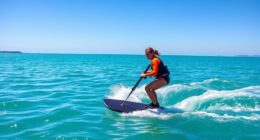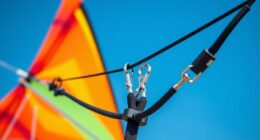When you're exploring the terminology, it's important to know the difference between 'sailboat' and 'sail boat.' A 'sailboat' specifically refers to a type of vessel that uses sails for propulsion. In contrast, 'sail boat' is a more general description that can apply to any boat equipped with sails. Understanding these terms helps you communicate better in sailing contexts and complies with maritime regulations. Mastering the terminology also boosts your confidence on the water. If you want to enhance your sailing knowledge further, there are plenty of resources to discover insights into sailing maneuvers and essential equipment.
Key Takeaways
- 'Sailboat' is the correct term for a specific type of sailing vessel, while 'sail boat' is a general description.
- Sailboats use sails for propulsion, unlike motorboats that rely on engines.
- Proper terminology is vital for effective communication and clarity in maritime regulations.
- Familiarity with essential sailing terminology enhances safety and experience on the water.
Differentiating Sail Boat and Sailboat
When you're discussing sailing vessels, it's important to know that 'sailboat' is the correct term, while 'sail boat' is just a general description. A sailboat is a specific type of vessel designed primarily for sailing, using sails for propulsion. This compound word distinguishes these vessels from other watercraft, such as motorboats, which rely on engines for movement.
Understanding this terminology is essential, especially if you're engaging in any nautical activities or discussions. While you might hear 'sail boat' used informally, it doesn't convey the same precise meaning as 'sailboat.' The latter is recognized in maritime regulations, ensuring clear communication in legal and operational contexts.
Essential Sailing Terminology

Essential sailing terminology is crucial for mastering the art of sailing and ensuring smooth communication on the water. Familiarizing yourself with key sailing terms will enhance your experience and safety while steering.
One of the most important components of your sailboat is the mainsail, the largest sail located behind the mast. It plays a significant role in harnessing wind power to propel your vessel.
Understanding points of sail is equally essential. These positions describe how your boat interacts with the wind. For instance, when you're sailing as close to the wind as possible, you're in a 'close haul' position. If you find yourself sailing perpendicular to the wind, you're on a 'beam reach.' Knowing these positions helps you optimize your sailing performance.
Additionally, the terms 'windward' and 'leeward' are essential. The windward side faces the wind, while the leeward side is sheltered from it. Grasping these terms and concepts allows you to communicate effectively with your crew and make informed decisions while out on the water.
With this foundational knowledge, you'll be better prepared to commence your sailing adventures.
Understanding Boat Components
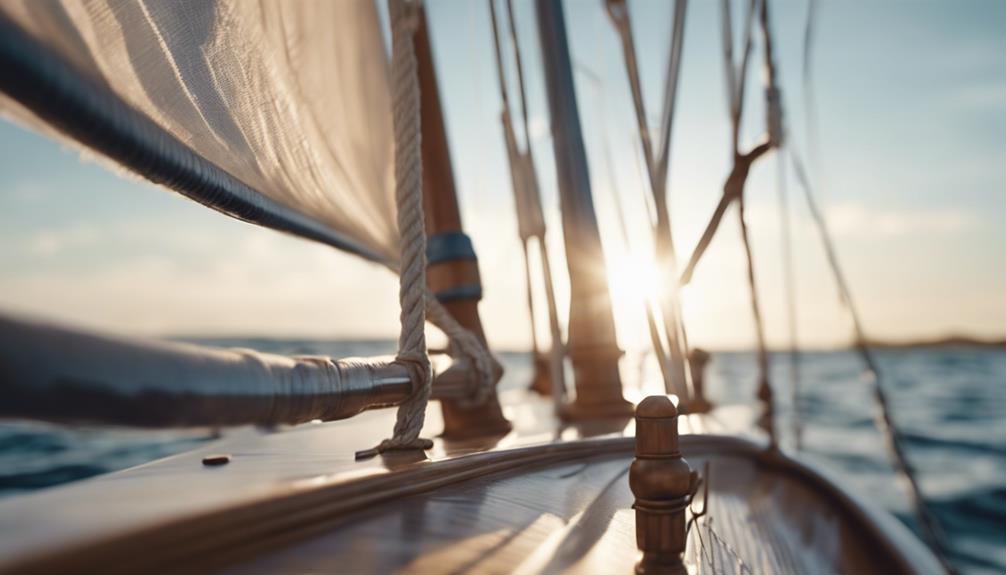
Understanding the various components of a sailboat is essential for effective sailing and navigation on the water.
The hull forms the main body of your sailboat, encompassing the bottom, sides, and deck. This structure offers buoyancy and stability, allowing your boat to float and navigate through the waves.
At the bottom of the hull, you'll find the keel. This heavy fin prevents lateral movement, providing significant stability against heeling, especially in strong winds. When you're sailing, the keel keeps your boat upright and helps you maintain a straight course.
The mast is another key component, rising tall and vertical from the hull. It supports the sails and rigging, enabling you to catch the wind effectively. The arrangement of the mast and sails determines how efficiently your boat can harness wind power, which is fundamental for propulsion.
Understanding these components—the hull, keel, and mast—will enhance your sailing experience. Each part plays an essential role in ensuring your sailboat performs at its best, allowing you to enjoy the thrill of sailing while staying safe on the water.
Key Sailing Maneuvers

When you're out on the water, mastering the tack and jibe techniques is essential for effective sailing.
You'll need to understand the points of sail to navigate efficiently and adjust your maneuvers based on wind direction.
Let's explore how these key maneuvers can enhance your sailing experience.
Tack and Jibe Techniques
Mastering tacking and jibing is essential for any sailor looking to navigate effectively and harness the wind's power.
When you tack, you'll turn the bow of your sailboat through the wind, allowing it to sail on the opposite tack, usually at a 45-degree angle to the wind. This zigzag approach is vital since you can't sail directly into the wind; it helps you make progress toward a windward destination.
On the other hand, jibing involves turning the stern of the boat through the wind, shifting from one downwind course to another. This maneuver can be trickier due to the potential for sudden changes in sail behavior, so you need to be alert.
Both tacking and jibing require you to trim your sails carefully to maintain speed and control. After each maneuver, adjust your sails immediately to adapt to the new wind direction.
Understanding the points of sail will enhance your tacking and jibing effectiveness. When sailing close-hauled during a tack, you'll maximize your speed, while jibing allows you to sail more comfortably with the wind at your back.
Understanding Points of Sail
Sailors often navigate through various points of sail to optimize their speed and maneuverability on the water. Understanding these points is essential for effective sailing.
When you sail close-hauled, you angle your boat at about 30-45 degrees to the wind direction. This position maximizes your forward speed while keeping the sails trimmed tightly.
As you gain confidence, you'll want to explore other points of sail. When the wind hits your boat from the side, you're on a beam reach, often the fastest point of sail.
If you adjust to have the wind come from behind at a 45-degree angle, you're on a broad reach, which provides a smooth, fast ride.
Roles on a Sailing Vessel

On a sailing vessel, each role plays an essential part in ensuring smooth operation.
You'll find the helmsman guiding the boat while the navigator charts the course, supported by the dedicated deckhands managing tasks on deck.
Understanding these key responsibilities will help you appreciate how teamwork keeps the vessel sailing efficiently.
Key Crew Responsibilities
Understanding key crew responsibilities is fundamental for a successful and safe sailing experience. Each role on the vessel plays an essential part in guaranteeing everything runs smoothly.
The helmsman takes charge of steering the boat, maintaining its course, and making real-time adjustments based on conditions. You'll often see them using a wheel or tiller to guide the vessel effectively.
Meanwhile, the navigator is significant for determining the boat's course and position. Using charts and navigational tools, they guarantee safe passage, avoiding hazards and optimizing routes. Their decisions directly impact the crew's safety and efficiency.
As a crew member, your responsibilities may vary but are equally important. You'll assist with sail handling, rigging, and general operations, all while following directions from the helmsman and navigator. If you're designated as a deckhand, you'll focus on on-deck tasks like managing lines and sails, alongside performing maintenance to keep the boat in top shape.
Effective communication and collaboration among all crew members are key. By understanding and embracing your role, you contribute to a safer, more enjoyable sailing experience for everyone on board.
Helmsman and Navigator Roles
The roles of the helmsman and navigator are vital for the effective operation of a sailing vessel, each bringing unique skills and responsibilities to the crew. As a helmsman, you're responsible for steering the sailboat, making real-time adjustments based on wind and water conditions. The navigator, on the other hand, uses charts and navigational tools to determine the boat's position and strategize the best course.
Effective communication between you and your navigator is essential. While the navigator provides course adjustments, you execute those commands to maintain speed and direction. In competitive sailing, these roles can be distinct, allowing each party to focus on their strengths.
Here's a quick overview of each role:
| Role | Responsibilities | Skills Required |
|---|---|---|
| Helmsman | Steers the vessel, adjusts helm | Boat handling, agility |
| Navigator | Plans course, manages navigational tools | Chart reading, strategy |
| Collaboration | Communicates course changes | Communication, teamwork |
Both roles require a solid understanding of sailing terminology to guarantee coordinated efforts and achieve ideal performance.
Importance of Deckhands
Deckhands play an essential role on a sailing vessel, executing important tasks that keep the operations running smoothly and safely. As a deckhand, you're responsible for handling lines, managing sails, and assisting with docking maneuvers. Your ability to perform these tasks efficiently is critical, as it directly impacts the vessel's performance and safety.
You'll also take on maintenance duties, which include cleaning, inspecting equipment, and checking rigging to verify everything's in top condition. Having a solid understanding of sailing terminology is necessary, as it allows you to communicate effectively with the helmsman and other crew members during operations.
Safety is one of your key responsibilities. You must remain vigilant about potential hazards on deck and guarantee that everyone is wearing appropriate safety gear during sailing activities. This vigilance not only protects you but also your fellow crew members.
Importance of Points of Sail
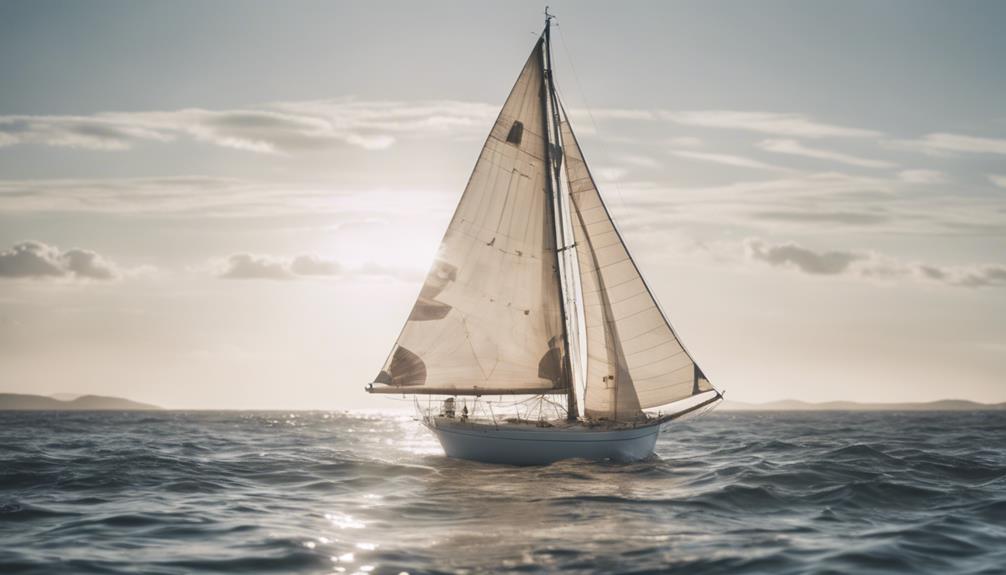
Mastering the points of sail is essential for optimizing your boat's speed and maneuverability on the water. The points of sail refer to the various angles at which your sailboat can travel in relation to the wind direction. Understanding these angles helps you sail efficiently, as each point offers different advantages.
For instance, when you're sailing 'close-hauled,' you position your boat at a 45-degree angle to the wind, allowing you to maximize speed and efficiency.
It's vital to know that sailing directly into the wind is impossible; doing so leaves you 'in irons,' where your sails luff and you lose momentum. Instead, you'll want to utilize points like a beam reach, where the wind comes from the side, offering the fastest and most stable sailing conditions.
Mastering these points not only enhances your speed but also aids in effective maneuvers like tacking or jibing. By knowing when to change direction, you can maintain your speed even while altering your course, ensuring you make the most of your sailing experience.
Navigational Terms Explained
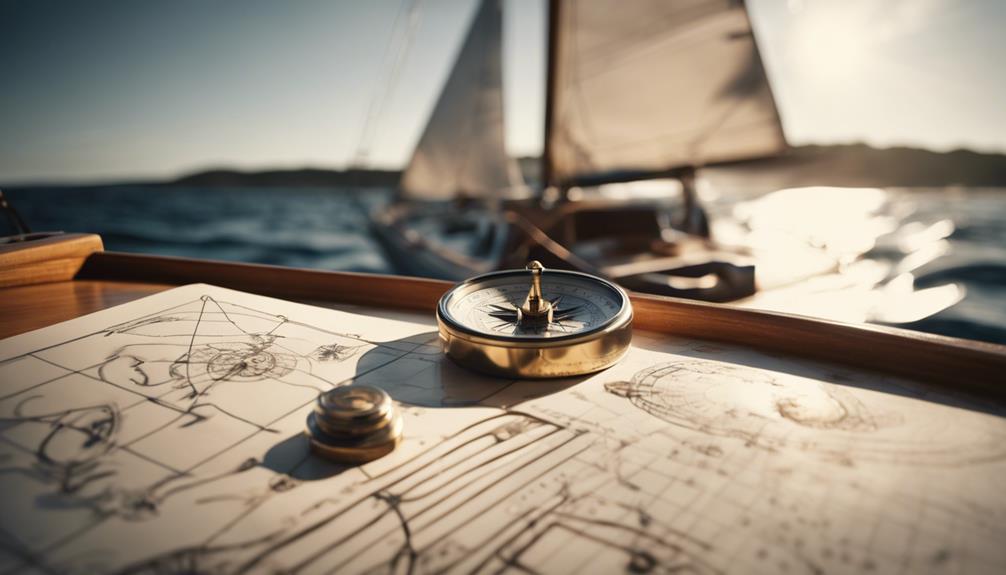
Navigational terms are vital for understanding how to safely and effectively chart your course on the water. Being familiar with these terms can enhance your sailing experience and guarantee you stay on track.
| Term | Definition | Importance |
|---|---|---|
| Nautical Mile | Equivalent to one minute of latitude, about 1.15 statute miles or 1,852 meters. | Used in maritime navigation for distance measurement. |
| Waypoint | A specific geographical location for navigation. | Helps you plot courses and monitor your position. |
| Current | The movement of water affecting your boat's path. | Significant to take into account for accurate navigation. |
Understanding these terms will help you navigate effectively. For instance, when planning your journey, you'll plot waypoints to guide you through your route. Remember that the current can influence your speed and direction, so it's critical to factor it into your calculations. When measuring distances, you'll use nautical miles to guarantee accuracy, especially over long distances. By mastering these navigational terms, you'll have the confidence to sail safely and enjoyably.
Common Sailing Equipment
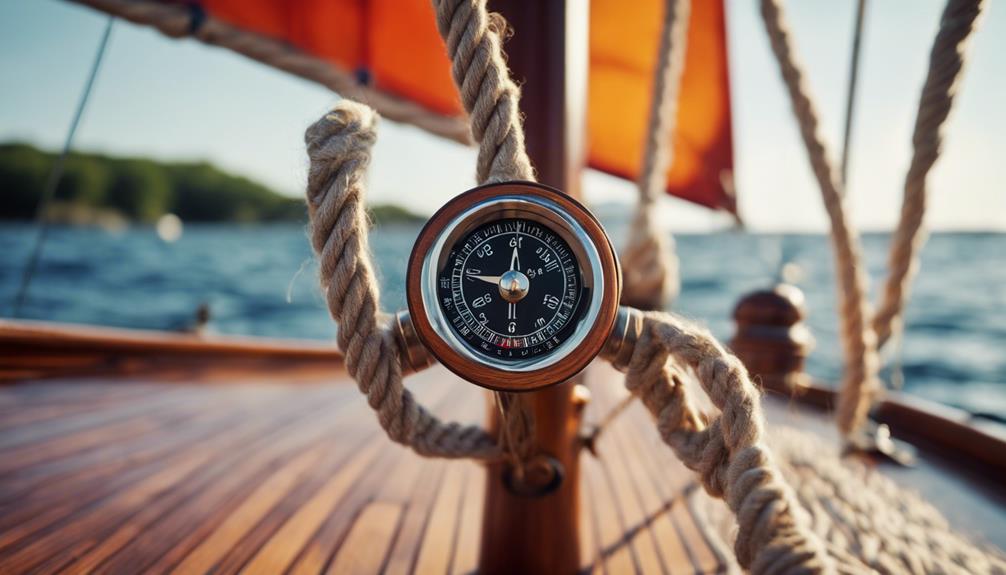
Understanding the terminology related to common sailing equipment can greatly enhance your sailing experience, making it easier to manage your vessel effectively on the water.
The mainsail is your largest sail, situated behind the mast. It's vital for harnessing wind power, and it typically has a boom that supports its bottom edge. Raising and lowering the mainsail is made simple with halyards, which are essential lines for proper sail positioning.
At the front of your sailboat, you'll find the jib. This smaller sail plays a significant role in improving your performance, especially when sailing upwind, and it doesn't require a boom. Together, the mainsail and jib work in tandem to maximize your sailing efficiency.
Stability is key while sailing, and that's where the keel comes in. It counteracts the lateral forces of the wind on your sails, providing balance and helping to prevent capsizing.
For added protection while docking, don't forget about fenders, which cushion your boat against docks or other vessels. Understanding these components will make your time on the water safer and more enjoyable.
Resources for Learning to Sail
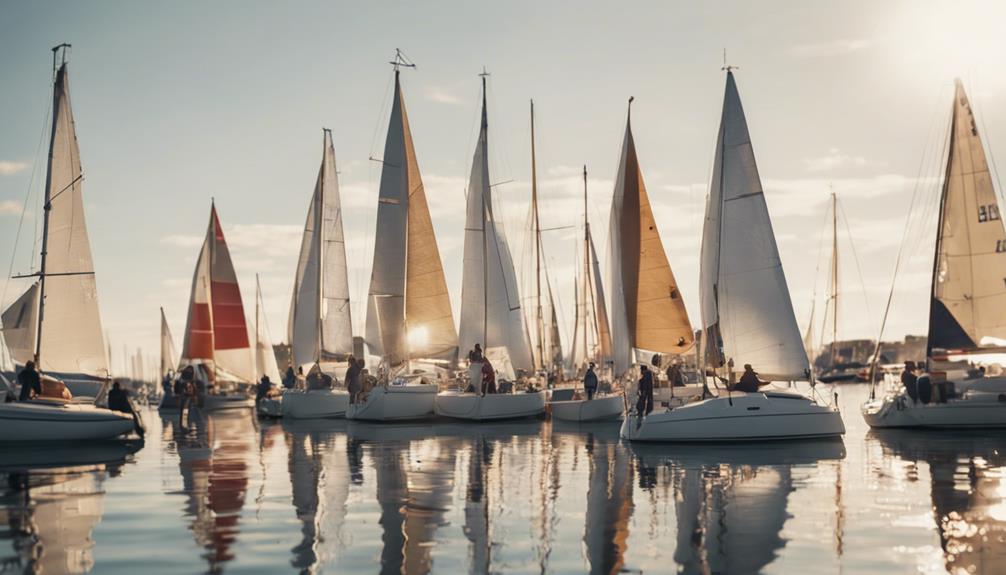
A variety of resources are available to help you learn how to sail confidently and effectively. One great starting point is enrolling in the ASA 101 course, which introduces basic keelboat sailing and is perfect for beginners. This course lays a solid foundation for your sailing journey.
To reinforce your knowledge of essential sailing terms and concepts, utilize online quizzes and interactive resources. They'll make learning engaging and fun.
Joining local sailing clubs or organizations can also be beneficial; they often offer practical sailing experiences and mentorship programs that cater to novice sailors like you.
Once you're comfortable, consider participating in sailing challenges and regattas. These events let you put your skills to the test while gaining real-world experience on the water. If you're interested in racing, explore performance racing seminars that cover racing strategies, sail trim, and competition rules.
With these resources at your disposal, you'll be well-equipped to learn to sail and enhance your sailing proficiency. Embrace these opportunities, and you'll be steering the waters with confidence in no time!
Frequently Asked Questions
What Is the Difference Between a Sailboat and a Sailing Boat?
A sailboat refers to any boat powered by sails, while a sailing boat often implies a vessel designed specifically for sailing activities, like racing. So, all sailing boats are sailboats, but not vice versa.
What Are the Three Corners of a Sail Called?
Imagine you're adjusting your sail on a windy day. The three corners of a sail are the head, tack, and clew. Each plays a crucial role in catching wind and optimizing your sailing performance.
What Is It Called When a Sailboat Has No Wind?
When a sailboat has no wind, you'd say it's 'in irons' or 'dead in the water.' In these conditions, your boat can't sail effectively, relying instead on currents or an auxiliary engine for movement.
What Is the Sail Called on a Sailboat?
On a sailboat, the main sail is called the mainsail. It's the largest sail located behind the mast, and it's essential for generating speed and maneuvering effectively through the water during your sailing adventures.
How Can I Incorporate My Sail Boat’s Name into the Terminology?
When it comes to incorporating your sail boat name into the terminology, get creative! Use it in radio communications, like “This is [Sail Boat Name] requesting permission to dock.” Or add it to equipment labels and personalized gear. Let your sail boat name ideas become a part of your sailing experience.
Conclusion
Now that you've got a clearer understanding of sail boat versus sailboat and other essential sailing terms, you're ready to initiate your maritime journey.
Remember, 'A smooth sea never made a skilled sailor.' Embrace the learning curve, familiarize yourself with the components, maneuvers, and roles aboard a vessel.
Whether you're a novice or just brushing up on your skills, the world of sailing awaits you. Set your sails, and enjoy the adventure ahead!







